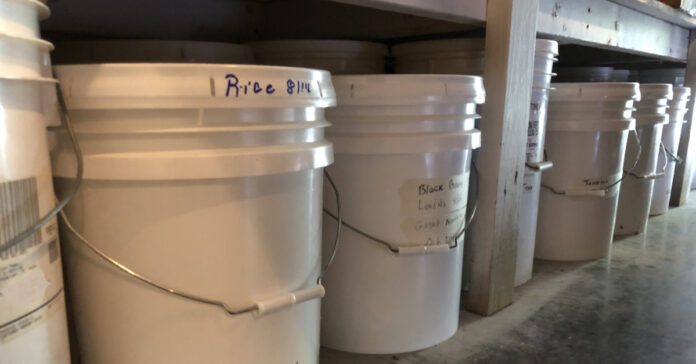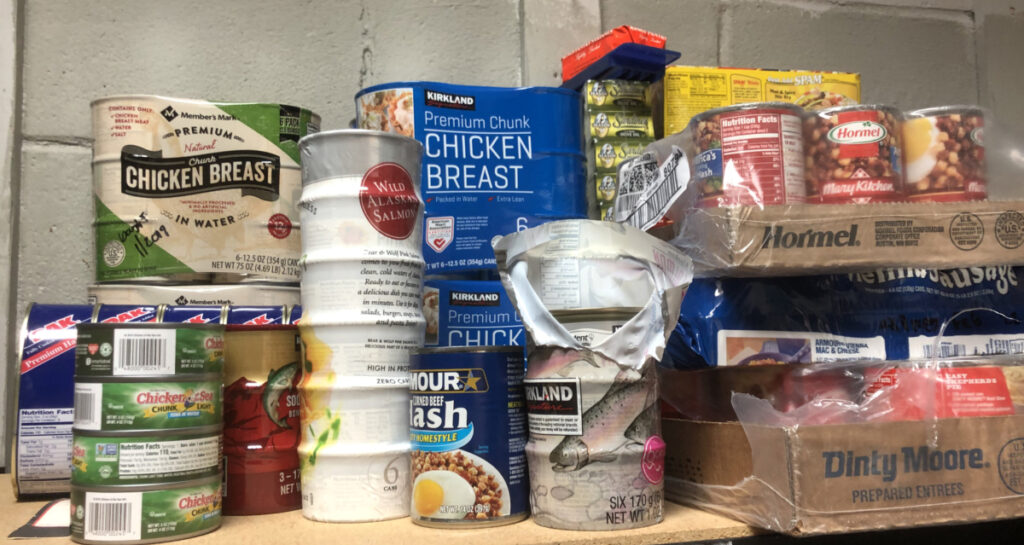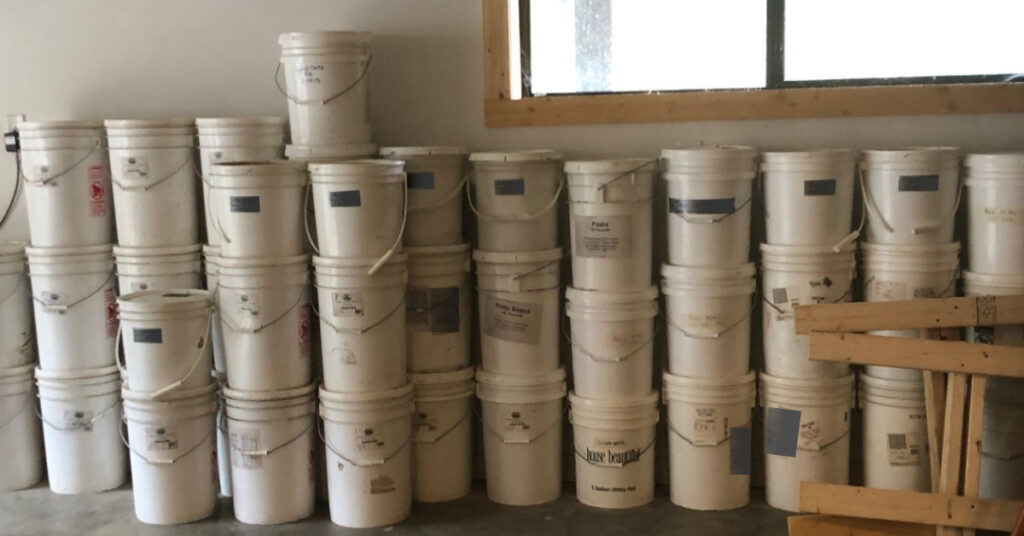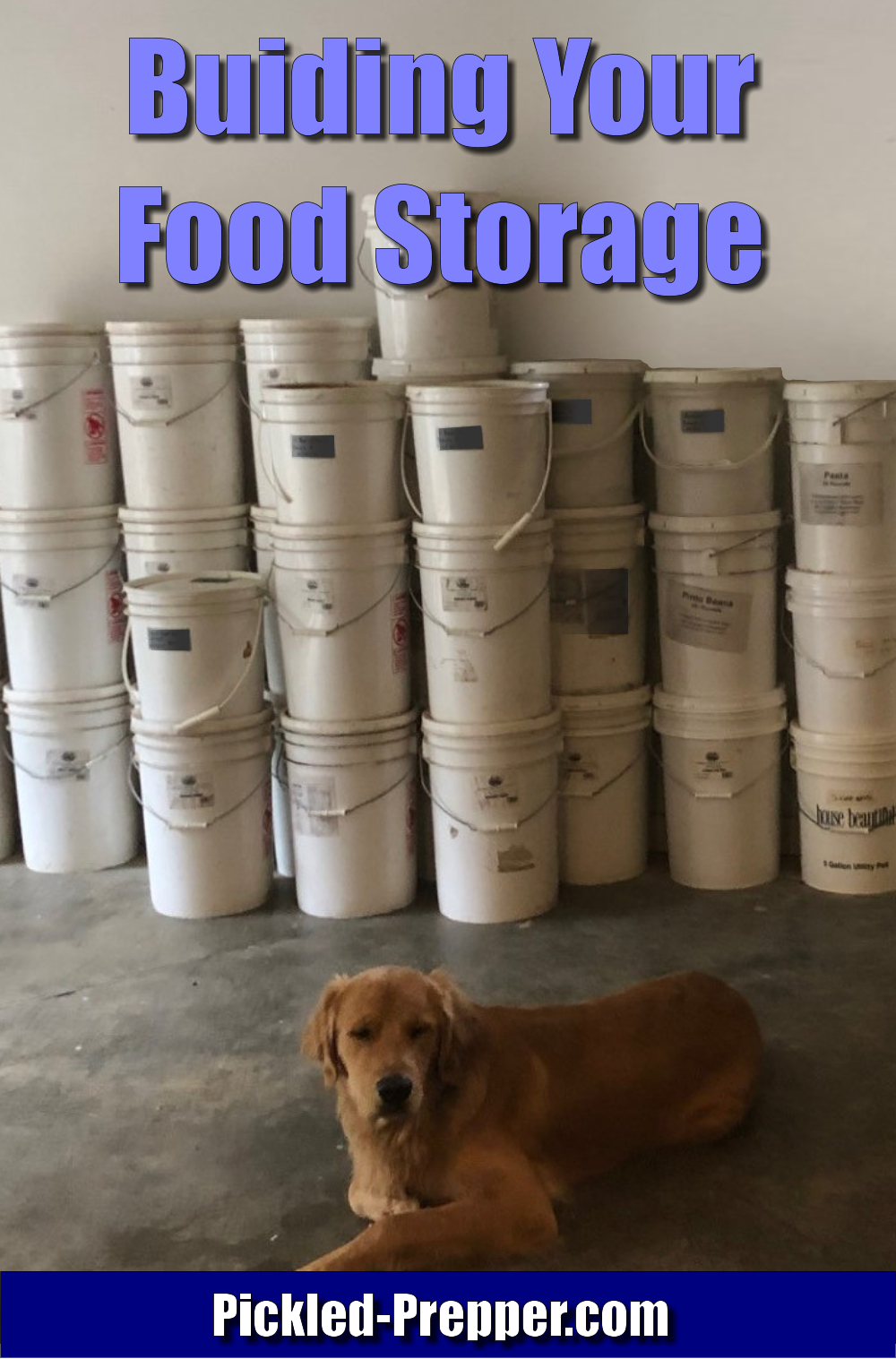
In yesterday’s post, I mentioned the government required prospectors heading into the Klondike in the late 1890s to have approximately 2,000 pounds of supplies with them. Below are the food items on the list published at the time by the Northern Pacific Railroad Company:
- 150 lbs. bacon
- 400 lbs. flour
- 25 lbs. rolled oats
- 125 lbs. beans
- 10 lbs. tea
- 10 lbs. coffee
- 25 lbs. sugar
- 25 lbs. dried potatoes
- 2 lbs. dried onions
- 15 lbs. salt
- 1 lb. pepper
- 75 lbs. dried fruits
- 8 lbs. baking powder
- 2 lbs. soda
- 1/2 lb. evaporated vinegar
- 12 oz. compressed soup
- 1 can mustard
I should note that the term “bacon” meant salted pork, not just the bacon we all know and love today that comes from the pig’s belly.
Let’s compare that to what the Church or Latter-Day Saints recommends their members store for one year:
- 400 pounds grain
- 60 pounds beans or other legumes
- 30 pounds powdered milk or other dairy products
- 60 pounds sugar
- 6 pounds leavening agents, like baking soda, baking powder and yeast
- 6 pounds of salt
- 30 pounds of fats, usually stored as oils, canned butter, etc.
Evaluating the Lists
Let’s examine this list and determine what we, as preppers, can learn from it.
The first thing that jumps out at me is they both want you to have the same amount of grain for a year, 400 pounds. They instructed the gold prospectors to bring 400 pounds of flour (plus 25 pounds of oats); the Mormons are instructed to store grains. This is because whole grains store much longer than flour. While there is some debate about storing flour, most agree that white flour lasts longer than whole wheat flour, which can go rancid, but wheat kernels or berries store the longest, often remaining viable for decades. Of course, you have to grind them to make flour, so be sure to store a grain mill or you will need to beat them with a rock like ancient cultures.
Note that for our purposes, pasta, cornmeal, grits, dried cereal, pancake mix, and anything else in which the primary ingredient is a grain would all count towards the 400 pound total.
They recommend 25 and 60 pounds of beans/legumes, respectively. I think both are too low a number. In my research, I have found that one should store about half as much legumes as grain. If you store 400 pounds of grain, I would recommend storing 180 to 200 pounds of beans or other legumes. (This can include peanut butter, split peas and lentils.)
We also see differences in salt and sugar. My guess is that salt was used to cure foods back in the late 1800s while today’s Mormons bake more than gold prospectors. That would account for the differences. Seeing that the prospectors carried two pounds of soda confirms this difference. They probably made quick breads in a frying pan while the Mormons would bake raised breads as well.
Meats and Fats
Cured, or salted, pork was a staple food in many kitchens until the proliferation of refrigeration. Because it stored well and was easily transported, sailors, soldiers, pioneers, and settlers also counted on it. It was packaged in wooden barrels or kegs loaded with salt, saltpeter, and sometimes brown sugar.
The LDS guidelines do not specify storing canned of freeze dried meat or meat replacements such as flavored textured vegetable protein (TVP). Instead, they recommend storing oil. In this category, I would be squarely in the gold prospector camp and prefer to have 150 pounds of bacon or other meats on hand. As frequent readers will know, we keep a good quantity of canned meats in our pantry and have a freezer full of meat.

The LDS recommends 6 pounds of oil per person. I think this is a little on the light site. We keep a couple of spare bottles of virgin olive oil and avocado oil in our prepper pantry, but for long term storage, we rely on coconut oil. In the 1990s, we kept big canisters of shortening, but the coconut oil has replaced those in our storage plans because it stores so well.
Other Foods
The experts also advised those heading to the Klondike to bring 75 pounds of dried fruits. Drying, or what we would call dehydrating, was the most common method to preserve fruit in the 1800s. My guess is fruit was recommended to prevent scurvy, a disease caused by a lack of vitamin C. Fruits are missing on the LDS list.
Potatoes were also suggested for the prospectors, but are not included in the LDS list. We have 50 pounds of fresh potatoes and onions on our emergency shopping list. We also have #10 cans of potato granules, potato flakes, and dehydrated hash browns in our storage room. Dried potatoes are good for your long-term storage food because they are inexpensive, familiar, and filling. You would not want to live on them alone, but they are a great addition to your food storage program.
The LDS recommends storing dairy products, including powdered milk and powdered cheese, but dairy is not on the prospector’s list. Powdered milk is frequently added to storage food packages to increase their protein content. We store very little, just enough for cooking, as neither of us adults drinks it. However, if you are prepping for young children, you should stock more of it.
No surprise that the LDS list does not include coffee or tea, but you should consider storing both if they play a big role in your life.
My Suggestions
As described in detail elsewhere on this blog, I believe you should have three layers in your food storage system: First, a prepper pantry filled with canned and dried goods with a shelf life of six months to two years. Second, are prepper staples, bulk supplies like those mentioned above packed in 5-gallon pails or #10 cans, such as wheat, rice, oatmeal, pastas, beans, dried fruits, dried vegetables, baking mixes, and drink mixes. Third, and only buy these items after you have at least a year’s worth of the prior layer, you can store expensive items like commercially freeze dried meats, MREs, and specialty foods.
I recommend stocking basic items that you can use as ingredients or as stand-alone dishes in addition to mixes. For example, it is usually less expensive to store elbow macaroni and powdered cheese rather than a macaroni and cheese mixture. However, I do store ABC soup mix and baking mixes.

Besides the basic grains, beans, fruits and vegetables, store some items that will be treats or rewards. This can include hot chocolate, cookie mixes, pudding mixes, Jello mixes, and muffin mixes. Maybe it includes coffee or alcohol.
Conclusions
Neither of these lists at the top of this post are perfect, but we can still learn from them. I suggest you review them and look for holes in your plans. Do you have enough food to feed your family for a year? If not, what is missing?
I know I find value in looking at what someone else does to prepare and seeing if I can learn from it or if they have included anything I have left anything out. In this regard, the clothing items on the Klondike list are of interest, especially things like three sets of long underwear, a dozen heavy wool socks, and six wool mittens. Makes me feel good about my stash of gloves and spare socks!
Prepping is a journey. If you feel the end is nigh, speed up your journey. The further along you are when the SHTF, the better.








